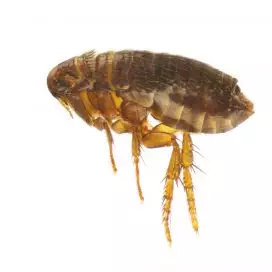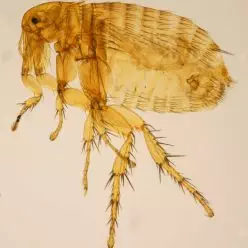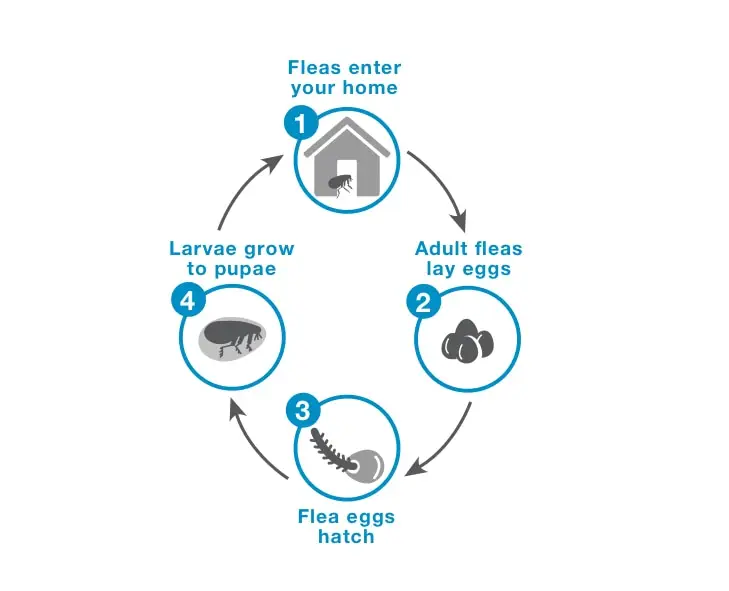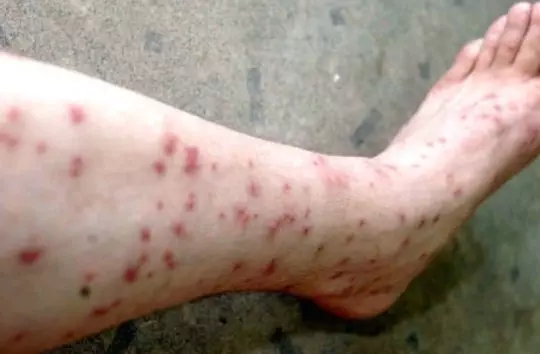
Fleas are a common pest throughout Auckland homes and offices, especially if there is, or was previously, a pet in the building. As parasites, the greatest concern about fleas are generally their bites, which can result in an uncomfortable itch or rash and even the development of allergies in some pets. They can carry bacteria pathogens and diseases.
Fleas are blood-sucking insects. They range from 1 mm to 5 mm in size. Their bodies are flat with a tough surface. In New Zealand, mostly three types of fleas are widespread. They have the potential to transmit diseases. Fleas survive from sucking blood. They feed on humans and animals. It is not easy to find out a flea infestation source and eradicate it. Therefore, it is important to follow some preventive measures to protect your home from fleas. There are different types of fleas and all the types survive on blood.
Considering one flea can lay up to 50 eggs a day, the quick an effective treatment of fleas is essential to prevent infestations.
Follow Our Simple Treatment Steps
Let Us Do What We Do Best
Our expert technicians will apply the optimum treatment to solve your pest issue.
Enjoy Your Pest Free Home
We send through a post treatment report and you get to breathe easy in your safe and clean home.
Common Types Of Fleas In New Zealand
There are many species of fleas. However, you will find four types of fleas in New Zealand. These are the cat fleas, dog fleas, rat fleas and human fleas. Among all of these, cat flea is most common in New Zealand. Fleas might not cause a serious infection. But flea bite can cause discomfort and pain to both humans and animals.
See our full article on the different types of fleas in New Zealand. If you are still unsure what type of flea you have, we can distinguish this for you and eradicate them with the correct solution.


Life Stages Of A Flea
A flea has four life stages. These are an egg, larva, pupae, and adult. Once a flea reaches the adult stage, it can exclusively survive on blood. Fleas have a specific mouthpiece that enables them to puncture the skin and suck blood. The saliva of a flea is antigenic and helps in feeding by preventing blood clotting. Also, fleas have three pairs of legs.
The adult flea usually lives on animals for easy feeding. Female fleas lay round and white eggs. These eggs fall off on the animal bedding, soil, and floor. The emerging larva depends on the organic material and the feces of adult fleas for feeding. After the required growth, the larva stage spins a cocoon and pupae. These cocoons remain invisible in the soil, under furniture, and carpets. These are also found on your animal bedding. High humidity, warm temperature, and vibrations from the movement help the pupae to emerge from the cocoon as an adult flea. The entire process might take two weeks. The maximum period is two years.
Many things depend on the humidity and the right level of temperature. Without adequate temperature and humidity, eggs might not survive. Adult fleas get attracted to the light source and hide in the shadows in the search of their host. An adult flea can start feeding immediately. Also, it can consume up to 13.6 microlitres of blood every day. They will die immediately after being removed from their host.

Health Risks Associated With Fleas
Fleas cause health issues. They can transmit contagious diseases from one host to another. They are known as the carrier of the plague. Also, a flea bite can cause a lot of irritation both in humans and animals. According to research reports, high levels of the bacteria are found in fleas. These bacteria are present on pet and fleas live and feed on pets. Researchers discovered that nineteen percent of fleas carried DNA of R. felis bacterium, eleven percent carried B. henselae and seven percent had B. clarridgeiae. Although cat fleas like pet blood, they can feed on human blood and transmit all those bacteria and cause health issues in humans. Also, flea bites cause rashes, swelling, pain and discomfort.

Treatment Of Flea Bites
A flea bite usually does not cause a life-threatening condition. If you get rashes and discomfort, you can see a doctor to know the possible treatment options. The doctor will suggest medicines depending on the condition. Some treatments are antibiotic and creams. The doctor might prescribe you oral antihistamines to treat swelling and itching.
Some soothing creams might be prescribed to prevent any secondary bacterial infection. The topical steroid will help to reduce the inflammation. Pain, oozing, pustules, redness, and crusting indicate a secondary bacterial infection. While experiencing any of these symptoms, it is better to consult a doctor. Your doctor might prescribe oral or topical antibiotics to treat the condition. If the bite is causing discomfort to your pet, you can visit a vet for the treatment. The healing period might take days to a week.
How To Prevent Flea Infestation
Flea infestations are difficult to eradicate. If you have a flea infestation, avoid using do-it-yourself flea treatments. Fleas have built a resistance to most over the counter flea treatments. A professional, registered pest control company will only use commercial grade pest control products approved by New Zealand’s Environmental Protection Agency. A professional pest control technician knows how to treat your home safely and effectively so you can be assured your family is in safe hands and the flea infestation will be eradicated.
Do you have pets? Remember to regularly treat pets with a quality flea control product. This will help prevent pets from bringing fleas into your home. Talk with your vet about the best option for your pet. You should also regularly hot wash and hot tumble dry (at least 55 C) pet bedding.

Fleas require a residual pesticide surface treatment, along with an insect growth regulator (IGR). The treatment works on residual contact; the flea must come into direct contact with the product and absorb the active ingredient, which then kills the flea by affecting the nervous system. You need to allow time for the treatment to kill the fleas and break the flea lifecycle. This can take several weeks.
How We Treat Fleas
Our technician will apply a residual pesticide surface treatment, along with an insect growth regulator where flea activity is prevalent e.g. on carpet, mats and wooden flooring. The treatment works on residual contact, which means the flea must come into contact with the pesticide and absorb the product. The product then kills the flea by affecting the nervous system.
The pesticide cannot penetrate flea eggs, or pupae. When existing flea eggs hatch, you may notice more activity, usually about 5-21 days after the initial treatment. We call this the ‘second hatching’ and it’s completely normal. The activity will reduce after several days as the new nymphs come into contact with the residual product. The insect growth regulator stops nymphs from breeding and laying more eggs.
Fleas can be mistaken for mites, however, the same treatment applies.
Internal – residual application of product to carpets.
External – powder treatment under-house if easily accessible.
You property needs to be vacated for 4 hours after treatment (including pets). Remember, it is normal to have a second hatching between 2-4 weeks after the initial treatment. Residual product will still be in place and working – activity should stop after a few days.
Flea eggs can lay dormant for a long time. Movement and vibration encourage eggs to hatch; if your property is vacant, we recommend a daily walk through to encourage hatching.
If wooden floors are washed after treatment all product will be gone – leave for 10 days to allow product to work. Do not vacuum for a minimum of 7 days after treatment.
Preparation
- Floors to be thoroughly vacuumed including under beds and/or furniture and skirting boards clear of dust. Vibration from vacuuming helps to activate flea eggs and picks up adult fleas and/or loose eggs.
- Vacuum bags should be sealed and disposed of after vacuuming.
- All personal items are to be removed from the floor.
- Floor should be clear and clean prior to our technician’s arrival.
Guarantee
Guaranteed for 3 months subject to pre-post instructions being followed.
Notes:
INFANTS – due to the sensitivity of infant’s skin we recommend offsite for a minimum of 12 hours up to 24 hours. If an overnight isn’t an option, book early morning treatment – can return after 5 pm. Keep infants off the carpet for 24 hours! Do not change the baby on the floor – use a changing table. There is no respiratory issue, but direct skin contact before the product is totally dry can result in bad skin irritation.
All animals (birds, cats, dogs) to be removed to the non-treatment area e.g. garage / if the garage is being treated animals to be removed from the site during treatment and for 3 hours after treatment. Dogs can be secured outside away from the treatment area.
Frequently Asked Questions
Flea bites are usually found around the ankle area (or body if they are in your bed).
They reside in carpet, mats and wooden flooring, on animals and animal beds/blankets. If you have pets that sleep on your bed, they may also be in your bed.



